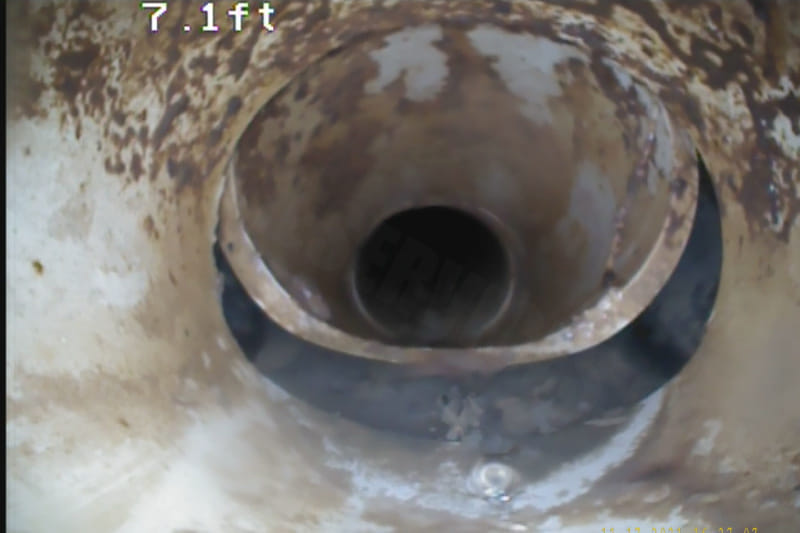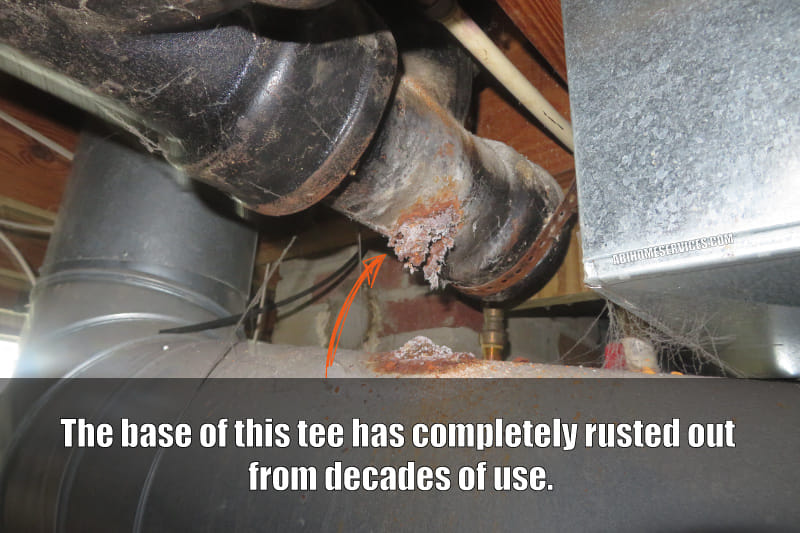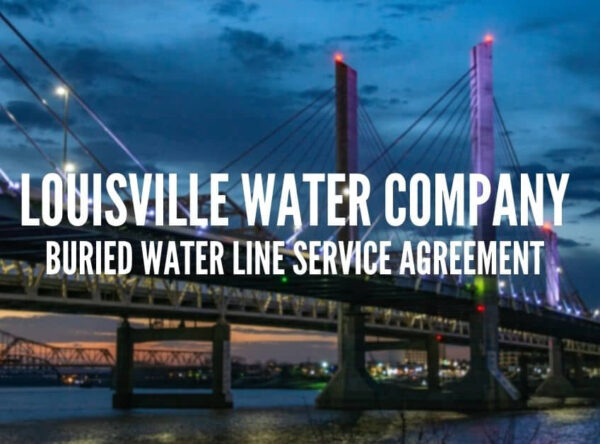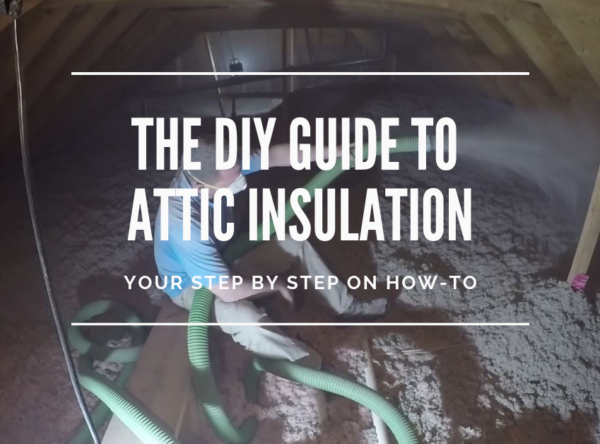Buying an Old House – The Plumbing System
Lots of people love the idea of buying an older house. They love the “character” that only old houses can bring. I get that. But I’m seeing a trend of people wanting to go this route with no knowledge of what it really means to own an old house or the cost of keeping one up and running.
Anyone who has lived in an old home for any real amount of time will tell you it’s a labor of love. Old houses need constant upkeep (more so than their younger counterparts), and if you have ever tried to re-hab an old house, you know it can feel like a huge hole in your yard that you dump money into every day.
You know, “the money pit.”
My city, Louisville, KY has an area of town known simply as “Old Louisville,” which is packed full of old Victorian-style brick houses. It is the third-largest such district in the United States. Old Louisville also has the largest concentration of homes containing stained glass in the nation. Pretty cool, eh? Needless to say, I get to inspect lots of big, old houses.
That, too, can be a love-hate relationship.
Let’s dive into the plumbing system of an old house. Old pipes can look fine on the surface, but looks can be deceiving. Over the past 100 years or so, several different types of materials have been used for plumbing in homes. Clay pipes, cast iron, and galvanized steel were the most commonly used forms back in the day. All of these have been replaced with modern PVC plastics in recent years, but millions of homes still have the old systems, and one day they will have to be replaced due to failure.
If you live in a house that was built prior to 1980, there is a good chance you have at least one, if not more of these kinds of materials.
If you are thinking about buying an old home, you’ll want to pay special attention to the types of plumbing system materials that it has. If your new potential home still has most, if not all, of the original pipes, you could be staring at a monster check one day to get things upgraded.
For clarity’s sake, the supply line is the pipe that brings water into the home and distributes it throughout. The waste lines are the pipes that take the sewer water away from the house.
Clay Sewer Lines
Clay sewer pipes (or vitrified clay pipes, if you want to be technical about it) are what most sewers were made from in the 1800s to early 1900s. Clay pipes have been around for much longer than that though. Some of the earliest pipes ever discovered date back to about 4000 BC in Babylonia.
The issue with having a buried clay pipe in your yard is that they are known for cracking or breaking over time because clay is brittle.
A clay waste (or sewer line) is comprised of many short sections of pipe that fit or ‘link’ together. They’re short because the pieces are heavy, but short sections mean lots of joints where bad things can happen.
Cue the tree roots.
When a breach in the wall of the pipe happens, roots, dirt, and everything in between begin to settle inside the pipe.
Over time this will lead to a clogged waste line in the yard of your new home.
At this point, there are two options. You can either dig up the yard and replace the pipes or hire a company that does “lining services.” That is, they claim to use the old pipe as a chase and pull a new liner through the old pipe. I’ve never seen this done, but in theory, it seems possible.
Below is an image from a sewer scope camera. These cameras are like a colonoscopy for your home. A technician can route this flexible camera down a sewer cleanout from inside your home and check the condition of your waste line from the house to the sewer tap at the street.
This house has tree roots that have worked their way into the waste and caused a blockage. Pay attention to the number at the bottom of the image. 167′ 5″. That means the camera ran out over 167′ to reach this blockage.
One of the hardest things to do at a home inspection is run enough water to catch a partially clogged line like this, especially in a vacant house that has had no water put into the sewer system for any amount of time. Most of these blockages are not 100%, and water will pass through the tree roots with little to no problem. It’s only when you mix in toilet paper and solid waste that things start to back up.

There are also times that the sewer pipe can fail and not have plant roots in the mix. Sometimes a tiny bit of water leaks out around the joints and over the years of use it causes a void to wash out under the sewer pipe. If this washout gets bad enough, there will not be any soil to support the heavy pipes, and things will fall out of place.
The image below is of a failed waste line that is just 7ft from the start point. The separation of the sewer pipe is clear, and anything but water will likely get hung up on the different levels of pipe, or just wash out of the gap between the sections of sewer pipe.
This too is a great example of why every older home should have a sewer line scope performed. Sometimes, just running lots and lots of clean water through the system is not enough to expose a problem like this.

Cast Iron Sewer Lines
Cast iron sewer pipes have been around a long time as well. It’s not uncommon to see cast iron sewer pipes last 80-100 years, sometimes even longer. However, some cast iron pipes have a certain type of failure that is easy to spot…rust.
The thing to remember is that cast iron rusts from the inside out. That means that while your cast iron sewer pipe may look fine on the surface, your line could be paper-thin in reality from years of corrosion and rust. Due to rising corrosive sewer gases, long horizontal runs of cast iron pipes also crack frequently along the top edge. These types of failures are not typically visible looking up in a basement or crawlspace, so you have to feel your way down the pipe for failure.
When you are looking at an old house, and you see cast iron pipes, pay attention to the areas of rust around the collars of the connections. That is where I typically find them rusting/failing.
Also, if you are seeing pipes that look freshly painted, it could be someone trying to cover up a badly rusted sewer pipe.

The thing to remember is that cast iron rusts from the inside out. That means while it may look fine on the surface, it could be paper-thin in reality. If the cast iron is around 80-100 yrs old, it’s getting close to the end of its life.
Galvanized Steel Water Pipes
Galvanized Steel Pipes were used as both supply and sewer pipes from around 1900 to the1960s in Louisville.
When steel has been galvanized, it has had a zinc coating applied to the steel to help prevent rust and corrosion.
Once the zinc coating wears off, the rusting begins. Galvanized steel water pipes are bad news in old houses.

They rust and close up like an artery that has seen too many cheeseburgers. You can also get some pretty nasty-tasting water from steel supply pipes that have rusted on the inside.
Louisville’s water is voted as some of the nation’s very best tasting tap water, and you wouldn’t want to spoil it with crud-filled water pipes. Obviously, when this happens it cuts the flow down dramatically as well. Like I said, bad news all around.
If the water in your home is brown at a sink or shower for the first second or two, but then turns clear it’s very likely you have rusting steel water pipes somewhere in the system.
Here is an old galvanized steel pipe that has been removed from service the home, but left abandoned in the basement.
Notice how it is rusting on the inside. This will continue until it stops flowing water altogether. But more importantly, do you want to drink water from this pipe?
I do still find old pipes wrapped in Asbestos pipe insulation a few times a year. Most of the time it is in bad condition and falling apart, which means it is friable and should be professionally removed.
The cost to mitigate such a situation can get expensive- like nice car money. The process is much like Asbestos floor tile removal.
Galvanized Steel Main Water Supply
One of the most expensive water pipes to replace is your main line feeding the home its potable water. These were used from the 1900s to the 1960s.
A lot of homes in Louisville still have their old galvanized main water lines in place, even ones that have been remodeled and or flipped, and despite what you may have been told, as the homeowner, you are responsible for the main from the meter to the house. That means if your old rusty galvanized water line fails in the yard, the water company is NOT going to replace it, that is on you.
Potable Water – also known as drinking water, comes from surface and ground sources and is treated to levels that meet state and federal standards for consumption.
The cost to replace this line varies greatly from house to house. A clear run from the water meter to the house can be as low as a few thousand dollars, but one that has to be routed under sidewalks and driveways can get really expensive. The old galvanized pipe is hardly ever removed. The plumbing contractor will just cut it loose from service and leave it in the ground to rot away.
Galvanized Steel Waste Lines
Main supply and distribution lines are not the only problematic material when it comes to galvanized pipes.
Lots of old houses have waste lines made of the same stuff. They, too, suffer from the same fate of rust and buildup inside the pipe over time. Typically, I see galvanized pipes being used waste lines throughout the house that tie into a cast iron main sewer stacks where it heads out to the sewer main.
It could vary from region to region, but I have never seen galvanized steel pipe used as the main waste line in residential construction.
Here is a picture of an abandoned galvanized waste line. Notice how it’s an old piece of galvanized pipe connecting into a cast iron main. Those two typically go hand in hand in residential construction.
So, as you shop for your new (old) house, pay attention to what you see in terms of plumbing pipes. A total plumbing replacement job on a house is “new Tesla money.“
If you notice little bits of PVC pipe sprinkled in here and there in the plumbing waste system, that is a sign that the owners have had problems in the past, but didn’t want to bite the bullet and spend the big money to have it all replaced.
It’s inevitable. These old pipes will fail. You just don’t want to be caught off guard when they do.
Note* The Louisville Water Company does offer a buried water line service agreement that for a few bucks a month you can get an ‘insurance’ against failures of your old pipes. I cover this topic in great detail here: Buried Water Line Coverage.













I am renting a house built in the 50’s, so I have a first hand experience dealing with outdated plumbing. I agree that a lot of people looking into buying an older house have no idea what to expect. When my husband and I buy our first home, we will definitely take a good look at the pipes. After looking at the picture of the rust on the inside of that pipe, I’m thinking it would be a good idea to have the outdated fixtured replace right away.
I just offered a contract on a house built in 1964 and did a sewer inspection today. The case iron pipe has some build up and flaking but no tree roots or clog in the system. The build up is more than expected for a 56 year old house per the person who did the camera inspection. Wondering if I should buy this house or not. How much build up is too much? He also said that I will likely not have any problems from this but no guarantees of how it would go.
We have a 1940s house. Our main concern has been the plumbing. We had the bathroom redone, and opened all of the walls, and lifted the floors. We had a galvanized tub drain replaced ( opening a wall in the front hall going down to the basement, and up to the 2nd story tub to do it), and had all the water lines replaced with L grade copper. We had the venting redone. Our main objective was to thoroughly inspect, and replace anything that was needed. In doing the job, the plumbers chose to leave a short horizontal line of cast iron from the toilet to the cast iron down stack. Shortly ( 2days) after the entire bathroom reno was completed, and all the walls closed up, this short line had a crack that caused water to rundown the walls, and damage the ceilings below it. This has now been repaired, everything dried out, and redone,but it ended up being a costly choice in judgement for the contractors, as they had to do all of the repairing of damage. They say they think the vibration of the saw cutting the old pipes during the reno caused the crack. They are confident the vertical cast iron pipe that leads to the basement from the bathroom is fine. Let’s hope so!
This coming spring we will be replacing the sewer and water lines from the street to the house. After that, we hope we are ok. The house is beautiful. I want to feel safe and happy here.
Hi Mia,
Hate to hear about your leaky pipes just after a long renovation. If you keep having problems, they can always cap off the system and pressure test it with air just like they do on new construction to see if anything is leaking. If air can escape the pipes, so can water. Good luck!
Thanks for your post! I genuinely enjoyed reading it.
I will make sure to bookmark your blog and will come back
at some point.
I wish I would have known this before I bought my house. My sewer lined failed a few months after moving in and my home inspector did not give me any warning about any of this! Why would they not say something?! Ugg….
Hi Amy,
I’m sorry to hear about your trouble. I wish I had a good answer for you about your home inspector not saying anything to you about potential issues with these old materials. You’d need to ask them about that. Sometimes inspectors don’t want to scare you off the house and risk losing the referrals of the agent. It happens. In case you don’t know they are services that can clear out roots and blockages with an auger style bit. It’s won’t last forever but can buy you a few years before you have to replace the pipe. Good luck!
Greetings! Recently completed a 100% overhaul of original plumbing in a 1911, 3 story, brick home with a full basement. All the old piping was replaced with new PVC (Sewer) lines and Pex (supply) lines. Also replaced the 4″ line exiting the rear of the home with SCH40 PVC from the basement wall to the connection with the city line. Only pipes we did not replace were under the basement floor. We’ve had no issues, thankfully.
My issue is with the interior, perimeter drain tile system. Must assume that all along the perimeter of the basement floor, there are 12-18″ drain tiles (pipes) buried to weep/wick exterior wall water from getting under the basement floor. My question is how and or where or should this collected water exit the network? It has to go somewhere. Does it or should it connect with the main sewer line, or is it a separate drain system? House was built in 1911 in Detroit.
Hey! What you are describing sound like a sump-pump perimeter drain system. Groundwater is collected around the foundation walls and drained into a crock in the ground where a pump is triggered by a float switch to eject it up and out into the yard. Again, this is only groundwater, not sewage. If you don’t see a crock/pump in the basement then it’s possible it was never built with one. I see that from time to time here in Louisville and you really don’t have a choice but to add one.
Hi sir, thanks for this info. I’ve own my old house since the mid 1980s. It was built in 1907. Everything is working good and replace PVC all above ground. The problem is my basement washer drain just got clogged, draining slowly over about 10 minutes. And I am sad to admit not having a proper cover on it. I did use a plunger but didn’t help. I’m worried about using a drain auger because I don’t know what the pipe is made of. At the top of the drain at the concrete floor it doesn’t look like a lot of rust. Thank you in advance. I hope you read this. Please let me know if you think a hand auger is alright or what I should do. Thanks again
Are we talking we a floor drain, or a washing machine standpipe?
The entire post absolutely ROCKS! Thank you! :)
What’s the best way to unclog cast iron drains which leads to a 1947 drain tile with a full basement ?
Hi Jill – You’ll want to have the lines camera scoped first to know what is causing the blockage. If you have a tree root problem you might be in replacement territory. Don’t go in blind and waste time and money without knowing what you are up against.
What’s the best way to unclog cast iron drains which leads to a 1947 drain tile with a full basement ?
Hi Jill – You’ll want to have the lines camera scoped first to know what is causing the blockage. If you have a tree root problem you might be in replacement territory. Don’t go in blind and waste time and money without knowing what you are up against.
Does anyone know any plumbing company that does non excavation pipe repair in Marshall, Texas? We have a home built in the 1930’s with an under the slab crack. We need to know something today!! Would welcome advice.
Does anyone know any plumbing company that does non excavation pipe repair in Marshall, Texas? We have a home built in the 1930’s with an under the slab crack. We need to know something today!! Would welcome advice.
Hi, glad I found this post. Bought a house built in 1953; no alarms from inspection. I didn’t move in right away b/c I had the hardwood floors refinished. Twice now a drain in the basement floor has backed up w/black sludge.
The first time I noticed it was just after washing dishes in my kitchen sink (dishwasher line needed adjusted/backing up in dishwasher). Not more than a gallon of liquid/sludge.
Three weeks go by, I’m full-time living e.g. showering, running the dishwasher, all normal stuff except laundry. Drainage around house needed repairs (just completed 4/16) b/c water was backing up in window well and coming in the basement window above washer/dryer.
Waiting on glass block window w/dryer vent before I hook up the washer/dryer. Worked in yard all day Sunday, 4/18, came in took shower. Black sludge returned; could almost fill a baby pool.
It was snaked the 1st time and I was told to use an enzyme-based drain cleaner to help clear the sludge. Been doing that, no issues again until Sunday. The AC line runs to this drain also so I didn’t consider capping it off. I’m not sure if this is an overflow drain only or something else and now but wondering if I can cap it off. If I do, where will this sludge go?
I do have a sump pump less than two feet away from this drain plus another drain (?- smaller hole in the floor where a sink may have drained to) in between the drain backing up and the sump pump.
You may be just the guy I’m looking for!! I had a hole develop in my yard and I don’t know what the clay pipes (I think) I’m seeing are. I live in George Rogers Clark Park, so while not technically Old Louisville, it’s close enough. Who do you think I should reach out to identify these pipes? MSD?
Hey Matt – I’ll email you so you can send me some pics. I keep my email off the site to cut down on spam. :)
So glad I found this.
1927 house connected to city sewer main. Recently had my line checked with camera and all is well except for a small crack in my sewage line that is going to be repaired.
My lines is at back of house and runs out about 20 feet to an alley n then connects to main…
BUT why am I smelling a STRONG sewage smell at the side of the house outside?
Again my line is in the back. The smell is around the side. Its awful.
I have a question….I had a cast iron sewer drain line that runs under my crawl space they found the drain line had become corroded and was leaking sewer/waste water into the ground. The old drain line was capped off and they redirected the line. I do live in a area that has a high water table, now when it rains a few days after I get a sickening odor. So my question is when a line has been abandoned and has substantial corrosion how should it have been treated, should the line have been completely filled with a slurry fill so stagnant water would not collect and cause this odor? I believe they ran just enough fill to cap off where the line was cut, but not to completely seal off the entire old line. Did not make sense to cap the ends when the corrosion is in the center of the pipe?
You’ll want to reach out to your local code official office and see what rules they have in place for the replacement of old waste lines. That is a permitted job here, which means the city inspectors have to come out and sign off on the work. It sounds like maybe your old line had standing wastewater in it, and I could imagine a scenario where that could cause a foul odor.
Thank you Ben I will check with the local code office.
I was wondering if you could tell me what was typically used (diameter wise) for the cast iron toilet drain pipe in a 1945 home built in Albany, OR. We are trying to decide if we want to deal with the possibility of new problems if we remove the existing cast iron flange in order to install an offset flange.
Context:
Minuscule (44″x78″) attic bathroom, under an eave, against a garage crawl space
Drain pipe is 11-1/2″ from finished wall, not including base board
Shower and sink already installed/finished, so can not afford to remove the flooring
Directly above another bathroom which was converted to a powder room — we don’t want to damage that bathroom’s ceiling — the point being that we may have less depth than others to work with — just the amount between floors using 6″ or 8″ joists (uncertain)
Drain pipe exits to the garage crawlspace
I’m not certain what else would be useful information.
Hey Jeanne, I am afraid I do not know what was requirements for OR in the forties were. However, most toilets are 3 or 4″ in size. Anything less will likely lead to trouble with draining.
I live in Texas and even though not in your area, I appreciate the education provided.
As an engineer I was surprised at the costs of replacement, the logic behind replacing old but seemingly more durable long lasting piping with newer “plastic” and the high level of plumbing issues that seem more common with plumbing systems that were supposedly “upgraded” and continue to have frequent unresolved problems. Now O can see what partial replacements, short term repairs and the hodge podge of combinations that are added, left undisturbed (or avoided) and how the cost should be weighed out beyond the immediate least expensive or invasive solution or temp fix, for whatever reason (financial constraints, lack of information or professional experienced bit practical involvement, lack of proper risk assessment, or simply not interested) and making the informed decisions in reference to how long you willl be affected, what additional costs and when could be necessary as corrective or preventive and of costs will increase or leave room for exponentially bigger issues or safety hazards and how to make informed knowledgeable decisions and feel in control or at least add trust and peace of mind to the relationship between me as homeowner and the potential service provider or contractor and that repairs will be to both satisfaction and understanding. I always appreciate a contractor who isn’t opposed to technical explanation nor questions and providing accurate (or an honest estimation am why) inspection or potential scenarios with options and each pro and con that can range from mandatory emergency containment to full scale preventive or predictive solutions which may be subject to what’s financially possible bs what would warrant additional funding if possible and how critical. I don’t think pretend to entertain DIY or cheap low cost on significant and detrimental home structures and systems. But understanding the problem
and how it will be addressed makes those decisions less difficult and less surprising when they do occur. Thank you for the valuable info and at least I can get a better idea of what could be lurking on my area and additional challenges associated with the modern plumbing dilemmas as well as my 1970 home.
House built in 1890 and has a drain in the backyard driveway.
Do these typically lead to pipes or just let the water dissolve into the soil?
Are we talking about the water supply line or the sewage (waste) line?